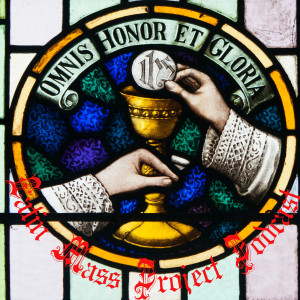
The Structure of the Traditional Latin Mass - LMP005
 2016-06-05
2016-06-05
Download
Right click and do "save link as"
Your browser does not support the audio element.
Podcast (15m57s): Play in new window | Download
The Two "Dismissals"
"Disciplina Arcani"
The Parts of the Mass
view more
The Two "Dismissals"
In looking at the broader structure of the Latin Mass, we can see that there are two basic parts that, historically, correspond to a rather practical reality. As we noted in episode 1, the word "Mass" comes from "missa," which essentially means "the dismissal," Originally, one would go "ad missam," or "to the dismissal," that is, "up to" one of two moments in the Mass as a whole at which a part of the people were dimissed: the dismissal of the catechumens (Missa catechumenorum) or the dismissal of the faithful (Missa fidelium). In the early days of the Church, catechumens (those seeking baptism) were not allowed to witness the offering of the Holy Sacrifice, and were sent out of the church right around the time of the Gospel (and probably before). The reason for this was that the Church took very seriously Christ's admonition to "give not what is holy to the dogs," reserving the holiest mystery (sacrament) for those who were already baptized. Only the initiate, or the faithful, stayed to the second dismissal, the end of the Mass as a whole.
Indeed, in the first five centuries or so of the Church's existence, it was customary to guard the most holy mysteries of the Faith from the uninitiate. Besides dismissing all but the baptized at Mass, the Church also did not typically write down the texts of the liturgy, or teach the highest truths and prayers of the Faith (the Creed, the Our Father, the Holy Trinity, etc.) to catechumens until they had almost reached baptism. Many of these things were passed on orally long before being put to writing. This "silence" with which the early days of the Church is marked has been termed the "disciplina arcani" ("the discipline of the secrets") by historians. It was especially strengthened in times of persecution, when the Church was already forced to be guarded and constantly on the watch. Yet even as the persecutions ended and Constantine converted and issued the Edict of Milan in the early fourth century, this "discipline" continued and was even further enforced as the Church wanted to guard that which was most sacred from a society that was still substantially pagan. It would only die out in the midst of a Christianized society around the 6th century.
Thus we have the following basic structure of the Mass, laid out in its most familiar texts:
Mass of the Catechumens
Introit
Kyrie
Gloria
Collect (Opening Prayer)
Reading
Gradual
Alleluia/Tract
(First Dismissal)
Mass of the Faithful
Gospel
Creed
Offertory (chant and prayers)
Preface dialogue/prayer
Sanctus
Canon (Anaphora or Eucharistic Prayer)
Agnus Dei
Communion (chant)
Postcommunion Prayer
(Second Dismissal)
Of course, there is no longer a "first dismissal," and though we still have "The Mass of the Catechumens" and "The Mass of the Faithful," the latter is usually marked as beginning at the Offertory, rather than the Gospel.
Another thing to note is that, in the Latin Mass, these texts are sometimes being said simultaneously with others. For example, while the choir sings the Introit, the priest and altar servers are saying the prayers at the foot of the altar. This once again calls to mind the way in which the Mass is a participation in the Body of Christ, with all the parts working in harmony. To someone used to the sequential/one-prayer-at-a-time structure of the Novus Ordo, the Latin Mass can be confusing at first. It is better perhaps for first-timers not to become overly concerned with following all of the texts, but rather to watch and experience the "motion" of the Mass.
More Episodes
Different Types of Masses - LMP006
 2017-03-01
2017-03-01
 2017-03-01
2017-03-01
Sacred Music Part I - LMP003
 2016-05-07
2016-05-07
 2016-05-07
2016-05-07
0123457
Create your
podcast in
minutes
- Full-featured podcast site
- Unlimited storage and bandwidth
- Comprehensive podcast stats
- Distribute to Apple Podcasts, Spotify, and more
- Make money with your podcast
It is Free
- Privacy Policy
- Cookie Policy
- Terms of Use
- Consent Preferences
- Copyright © 2015-2024 Podbean.com




